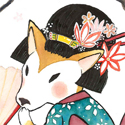|
 The Tighter the Curl, the More Concentrated the Evil Dogs had to come from somewhere, right? This is the thread that talks about the ones closest to their point of origin - the wolf. The domesticated dog has been around for roughly 15,000 years, and has been used to help man in things from protection and hunting to companionship, beasts of burden, and meat/fur. Of course it’s hard to pin point exactly when wolf and man began working together, and exactly why, but it’s obvious that both sides had something to gain from the relationship. Taming the beasts also meant that subsequent offspring would become more tame with each generation, as well as showing different behaviors from their wolf ancestors, ones that would be more beneficial and pleasing to humans. Over time, behaviors as well as appearances would differ from the original wolf (a recent example would be the Domesticating of the Silver Fox project in Russia.) It wasn’t until later that aesthetics over function would be selectively chosen and sought after. Many of these dogs have kept that wolf-like appearance as well as more of a primitive attitude that differs from those of the everyday willing to please Labs, but they still have very uniquely dog-like personalities and tendencies. Scientists once thought dogs originated from wolves in Asia, but recent studies have found all dogs share most DNA sequences with Middle Eastern canids. It's possible that dogs originated from wolves in the Middle East, but that different breeds had different outside wolf influences from wherever they were from. Meaning, dogs from America have influences from American Wolves while dogs from Asia have influences from Asian Wolves, etc. That is also to say that the early domestication of the dog (and even later development of specific breeds) were bred and cross bred back into wolf gene pools. The relationship to wolves wasn't clear cut in that dogs from region A are more wolfy than dogs from region B, but it's rather broken down into specific breeds, regardless of location. So, that's why the dogs in the "primitive/ancient" group are made up of dogs from Asia and the Middle east, and why some breeds from those regions aren't included; location doesn't matter, the specific breeds do. (nature, vol 464) Ancient Breeds include: Afghan Hound Akita Alaskan Malamute Basenji Chow Chow Dingo Lhasa Apso New Guinea Singing Dog Pekingese Samoyed Siberian Husky Shar-Pei Shiba Inu Shih Tsu Tibetan Terrier 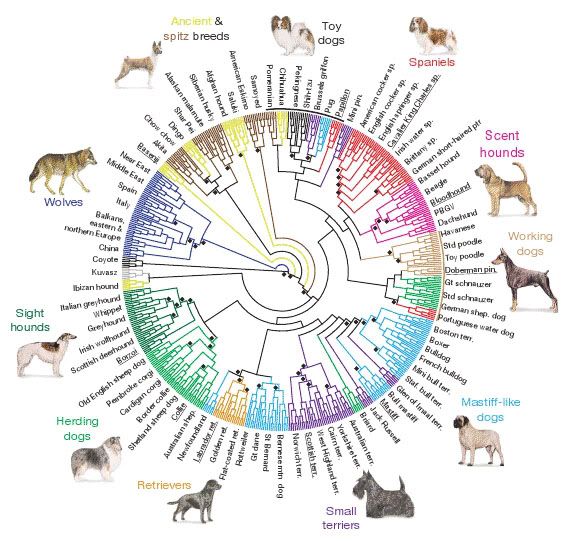 The bolded from the above list are the ones that happen to be linked most closely to their wolf ancestors within this primitive group (not all primitive or ancient breeds are included in this list, just the more popular or recognized ones.) As you can see, they are pretty much either Asian or Middle Eastern in origin, and just so happen to be the more wolf-like or spitz type dog. This thread will focus on more toward the spitz breeds, but is still open to all primitive discussions. They’re so pretty, buy why won’t they listen to me? DON’T THEY LOVE ME?! In a word, yes, but they’re complete assholes. These dogs thrive off of bribes (toys, treats and less so, pets and attention), and the NiLiF method of training, because if there is nothing in it for them, they just don’t see the point. These dogs are in it to win it, and the “it” is instant, personal gratification. Even if you ask something of them, it’s usually most effective to make it seem like it was their idea from the beginning. Think of a toddler perpetually in their terrible twos/MINE stage, and that’s what its like to deal with these dogs. They’re moody, aloof, drama queens, sensitive snowflakes, and at times, snarky. Great socialization with these dogs are absolutely the key, since without it they’ll turn into neurotic, untrusting dogs that most likely will not get along with others without a solid foundation. These dogs will always have something better to do than what you want them to. Nothing against you personally (or perhaps it is), but these dogs long for the great outdoors, the wild adventures, the great prey, the new smells and think they will find their way back home when it’s over eventually. Maybe. If they don’t find something else more interesting over there, first. With many of these dogs being used at one point for hunting purposes, their prey drive is higher than others. It creates a sort of tunnel vision where they MIGHT hear you, but they’ll be there in just a minute, there’s this thing over here, and before you know it they’ve taken off god knows where. And to most, nothing is more fun than a session of “chase me through the traffic!” when they realize you’re coming after them. That’s why the only way to be sure you still have a dog that hasn’t been lost to the dangers and distractions of the outside world is to make sure they are ALWAYS on a leash whenever they aren’t in a secured area, and harnesses or martingales are highly recommended, as well as real walls and secure doors. These dogs are also problem solvers and possible escape artists, so proper door manners (i.e. waiting away from the door when open) and high, secure fences are the only way to help contain them, since recall is almost never an option. Goodness me, why would anyone ever own one of these hellbeasts? Well, you’ve gotta admit, being gorgeous certainly doesn’t hurt their case. But many people feel like a dog that doesn’t have to be all in your face, needy for attention and affection every waking moment is quite appealing, and some people just get them and all their cat-like tendencies of being the biggest douche on the planet. But all of that aside, these dogs tend to be one person, or one family sort of dogs which in turn has made some of these breeds some of the most loyal dogs around and have been prized for such qualities. They tend to be more reserved and not waggy “pet me pet me!” like other dogs are around strangers, but are affectionate and playful around those they know well. These dogs also had a function, being hunters for things like boar, bear, rabbit, quail, pheasant, etc., as well as working dogs for hauling (like sled dogs) and while not all are still used for such functions, some are and are considered to be a valuable tool for these things even today. In addition to being described as a cat-like, independent dog, primitive breeds all seem to share a habit of grooming themselves as well as staying clean. These dogs will literally lick themselves like felines and seem to not like wet and dirt, and will usually try go out of their way to avoid such things. This fastidious nature makes the necessity of bathing far and few between, and lends to a happy and clean home. Save for all that fur...  HOLY poo poo DO THEY SHED Many of these primitive breeds have something called a “double coat.” A double coat is a coarse top coat while having a softer, plush undercoat and is generally referred to a “fur” coat, while many “single coat” animals are referred to having a “hair” coat. Dogs with a double coat have a fur that helps insulate them from both heat and cold, debris, the sun, water, in addition to making them huggably soft and generally ultra fluffy. Typically done when the weather starts getting warmer, and again while getting colder, the undercoat sheds with great abandon in order to make way for a warmer or cooler undercoat, depending on the climate needs and will last anywhere from 2 weeks to 2 months. Dogs with double coats also living in a warmer or cooler climate year round will have a coat that matches their needs. For example; a dog living in the southern United States will not have as thick of a coat as a dog living up somewhere in Saschachuan, even in the dead of winter. For this reason, dogs with double coats should NOT be shaved, as their natural protection from all elements will not only be lost, but their coat will become damaged and will not grow back in the same way. “My puppy is trying to eat my wife and child, he’s just so aggressive!” Many times play is mistaken for fighting with the primitive breeds. Style of play tends to be more rough than other dogs, (charges, butt bumps, wrestling, mouthing) as well as coupled with a lot of vocal sounds and flashy teeth, but it’s all a show. Posture and body language is a way you can tell play from fight. Relaxed mouths, ears and stance, as well as the obligatory butt in the air and rolling around are all signs of play, no matter how vocal or wolverine-like they might sound. Examples of play can be found here and here. Of course, this isn't to say these dogs don't fight, but there is generally a finer line between the two with more primitive breeds, and it's best for an experienced eye to judge when rough housing gets too far. Common Health Issues Many of these breeds tend to suffer from three common ailments; patella luxation, hip dysplasia and rampant allergies, both food and envrionmental. The best way to ensure your dog is not affected by such ailments is to go through a reputable breeder that health tests before breeding their field or show proven dogs and can show and explain what the results mean as well as why they chose that particular pairing. Treatment includes supplements, low impact exercise and surgery for joint problems and a strict allergen free diet as well as things from wiping paws to flea treatments to Benedryl and allergy shots. Links to Breed Specific Posts: Wolf Wolf Hybrid New Wolf-like Breeds Husky Akita Malamute Shar Pei Shiba Inu paisleyfox fucked around with this message at 07:06 on Mar 28, 2011 |
|
|
|

|
| # ¿ Apr 28, 2024 03:20 |
|
There, you happy? Anyway, WolfBag and I will be writing up posts on specific breeds, though feel free to contribute things as you see fit! We've got a good chunk of them covered, but there are still others we may need some volunteers for. We'll shout out to let you guys know. Now get to posting! 
|
|
|
|
adventure in the sandbox posted:One question though from the OP: "dogs from Asia have influences from Red Wolves." Red wolves only live in North America. All Asian wolves are grey wolf subspecies. Haha, I'm an idiot. Sparklepants posted:I saw that you had a Norwegian Elkhound picture, is that in fact an ancient breed as well? I'm just curious as my family used to have one and he was neurotic as hell. Actually, I believe it's an Akita picture I used, but yes Elkhounds are ancient spitz breeds.
|
|
|
|
Just had to share this. While I was looking through pictures on my computer for something completely unrelated, I found a picture of my husband's old dog, Silver Hawk.  Hawk was one of the best goddamn dogs ever. He was an American Eskimo that my husband picked out as a puppy when he himself was about 2. That dog was everything a fine Eskie should be, though could never be shown because of the weird crook his right ear did (which made him so friggin adorable, too). This dog lived until he was about 19, when the family decided it was best he was put down, as he wasn't excited about going outside or eating food much less getting up. Even though this dog wanted to eat my face the first time we met, I earned his love by many bribes and treats and it wasn't long until he wanted to put his head on my lap so I could scratch it with my long fingernails. I miss that dog so much. I think he and Koji would have had so much in common. 
|
|
|
|
Magikarpal Tunnel posted:Apparently Akita Inu and American Akitas are separate breeds in some places? Anyone know why? Well, my breed post should be up next week sometime, but the short of it is that they really are two separate breeds, even if the US and Canada (?) still put them in the same category. It has to do with trying to bring them back from the brink of extinction around the time of the war, where they didn't really have a standard back yet, and breeders who would breed bigger, more tough/bear looking dogs were the ones standing down by the military bases, selling dogs to the G.I.s for them to take home to their families in America. Some 60 years later, the Japanese and the Americans are found to have bred the dogs to have vastly different qualities. Japanese Akita tend to be leaner, longer legged and still look very fox like, almost like GIANT Shibas, especially since at the moment the red coloring is really favored in the Nippo ring. Americans, on the other hand, seem to like the stockier, more robust build of their dogs, faces tending to look more on the bear side with an personality that differs ever so slightly from their Japanese kin (tend to be more guard-doggy in the US, though general attitudes are VERY similar.) An American Akita would do poorly in a Nippo show, as would a Japanese Akita in an AKC or CKC show. Think of it like American English and British English. Two nations separated by a common language. It's the same with the dogs.  Japanese Akita and American Akita  
|
|
|
|
a life less posted:What are Akita energy levels like? Haha, well compared to my monster, I consider Akitas to be a little more laid back than crazy zoomie Shibas. They do get bored easily, though, and of course rotating toys, long walks or jogs, a job, daily training for mental exercise will always be the key for any of these dogs. Also, "teenaged" Akitas (or Shibas for that matter) are a loving nightmare, but goddamn if you can get past that stage with a firm stance, they are AWESOME dogs, but they will test every bone in your body to get there. (Say goodbye to your floor and door moldings, table legs, books, cabinet doors, and anything you hold dear...) BUT, the good thing about getting one young and from a reputable breeder would be that if you take that dog everyfuckingwhere, it will be more well adjusted and ready to open other people and dogs (and some even do pretty well with cats.) I mean, as a whole they're a little more reserved around other dogs, but honestly I haven't heard of people having too many problems if their pups have been properly socialized, and there are a few I get to play with at our dog park from time to time. Now, there aren't too many Japanese Akita breeders in the US, and the ones that are here either a) don't speak English, or b) aren't that great of a breeder...
|
|
|
|
COWER AT THE MIGHT OF THE JAPANESE! Kishu, Akita, Kai, Shiba. Y'all have no idea how much I wish I could take every one of those jerkoffs home.
|
|
|
|
HondaCivet posted:Augh I love these breeds, so pretty and naughty. 1) Yes. Yes they are. They're still dogs, don't get me wrong, but they are the same sort of aloof, I know better than you do, begrudging attitude cats have. 2) It really depends on the dog. My dog thinks cats are AWESOME and tries to wag his whole butt in the air and will bark at them. Then gets bored when they don't do anything and will walk away. Other want to eat them. I will say, though, my in-laws' cat isn't very amused by Koji, but she's an even bigger rear end in a top hat than he is, so meh. 3) Not really, I guess. Koji is my first dog EVER. But I knew what I was getting into, I was involved in breed specific forums, hounded the rescue I now volunteer for, and played with my friends' Shiba, Dug, as well as my husband's Eskie, so I kind of knew what to expect attitude wise. Fostering, finding a local breed rescue, or a meetup group would be a great way to break into it. 4) 8( OKAY.
|
|
|
|
Abandon All Hope posted:Hey Paisley Sure, I'll see what I can do. I still have the article in PDF at home, so when I get back tonight, I'll try to get a larger copy for you. rivals posted:This is interesting to me because I've actually heard that about Akitas as opposed to American Eskimos. Admittedly, I don't know much about either breed. It's kind of true across the primitive breeds in general. A lot of it still has to do with how much socializing they've had, but when it comes right down to it, it's really up to the individual dog. Every Akita I've meet has been a great squishy ball of aloof fluff, though I have heard stories from people I know well with bites, though honestly I don't know the details of said situations. From my experience, they tend to not just go in to bite unless they feel extremely threatened, and they're all also really mouthy dogs. The only time I was ever bit by my husband's old Eskie was when I accidently stepped on his foot, and he didn't break the skin. But while Hawk got better in his old age, and after the move from the house he lived at for 17 years, he never ever once had a problem with other dogs, it was just other people coming in on his territory he hated. Then again, he was shoved outside for most of his life, which is why I made good friends with him so he'd have a buddy when I'd be over.
|
|
|
|
Wally P posted:Sweet! Looking forward to the Akita post. After much discussion and many visits, etc, I'll be fostering (my first foster!) an Akita from the Mid-Atlantic Akita rescue group. It's going to be a big challenge as Kodi was severely neglected and undernourished when he was brought to the shelter (where he further deteriorated), so he is extremely anxious around strange humans. But according to the adoption coordinator (who is currently fostering him), he is fine with cats and other dogs.
|
|
|
|
WolfensteinBag posted:Overall, I'd say you need to have a very calm, confident attitude when it comes to these dogs. They need to know you're in charge and that things don't phase you. The SECOND they see you falter, they take advantage. Contrary to what a lot of people think, this doesn't mean you need to "dominate" them, yell at them, or constantly correct them, but rather they have to get the general sense that you won't accept any poo poo on your end, so they won't even bother. It's really a hard thing to explain, that's why getting to know other primitive breed owners is the best experience you can get. I just wanted to requote this, this is VERY important to understanding these dogs (and I'll probably add it to the main post.) Koji has learned, not overnight mind you, differences in our tone when we go to correct him. He knows between the "be nice~" and "if you don't stop that poo poo right now we are leaving" sort of tone. Does he still test us? Every single step of the way, but he knows when we mean business since we stay firm. (No, you may absolutely NOT stand by the door when it is open until I say so. Get up and the door closes and we do it again.) They pick up that the fastest way to what they want, or the way to not get their fun/stuff taken away is to listen. That also means you have to follow through on what's important, too. Sometimes you pick and choose your battles. Yeah, he's not NORMALLY allowed on the couch, but this time is okay, so long as he gets off when you ask him to. You also always want to set your dog up for success, not failure. So with your dog, you will learn the signs that will lead up to certain undesirable behaviors and be able to stop it before it happens with distractions. Get worked up and the dogs get worked up themselves. It is hard to explain, but if anyone has ever had first hand experience in a daycare or with young children, you will know EXACTLY what we are talking about.
|
|
|
|
HondaCivet posted:Anyway, I thought I'd heard that these types of breeds tend to be more fastidious than the average dog, is that true? Like, I heard that they wash themselves sometimes. Y'know, just to add to the "ways primitives are like cats" list. YES! Koji is like how Cpt Foxy described Keeper. He licks his paws, leaps over dirt, and seems to get his panties in a bunch when I make him walk through wet grass. The only thing Koji doesn't do like cats is the part where they lick their paws then rub their head. He FLIPS the gently caress out over his own poo (especially if he's eaten hair and it...hangs there It's pretty sweet. ETA: Hey, Abandon, I managed to piece together a larger version of the gene wheel from nature Magazine for you. It's roughly 1700x1500. I can go even bigger, the lines and text will translate into any size, but unfortunately much bigger than this and you'd have to find new pictures of the dogs since they start to get really pixelated. paisleyfox fucked around with this message at 05:18 on Sep 3, 2010 |
|
|
|
GundanianBlitz posted:"A cat? Where?!" Except for the occasional geek out over each other's dogs. Yeah, Koji is a rescue too, though they didn't get rid of him for another dog (at least, I don't THINK they did...) they just said didn't have enough time for him and their 7 year old. My dog, now. v
|
|
|
|
Kerfuffle posted:Are spitz doggies generally good/bad with other dogs? I'm aware of Akita's gender aggression but not much beyond that. A lot of them do have gender aggression, though again, a lot of it has to do with the individual dog. Koji thinks he and everyone else in the world are BFFs. Jiro (my friend's Shiba) HATES with a PASSION any Boxer, Husky, or black person (he can't see very well, though all he does is bark up a storm. He does the same with a white person in a dark room.) One awesome breeder that's here locally received 2 imported Shiba pups for show. One went to a pet home while the other was kept to be shown. Both look very nice, fantastic markings (especially for B&Ts) and even won some puppy prelims. The pet home dog has issues with several dogs (save Koji, oddly enough), including Jiro and my friend's Kelpie, who he just bit on the ear out of the blue. The show pup was injured and isolated for a while while he recovered and turned out to be the biggest mess as far as temperament goes, he can't be around ANY dog without going completely nuts. I really do think tolerance has a lot to do with socializing and desensitizing, especially when they are still young. Koji used to flip out about little children, but shoving treats in his mouth and slow introductions has made him realize that they're not so bad (and they usually have something sticky and delicious on their hands.) A lot of these dogs were bred to work alone or with a small pack (save sled dogs), just because a huge group of them wasn't necessarily needed. They don't necessarily have the same attitudes now that many bullies do with their intolerance around other dogs, mostly because many of these breeders have been really looking at a family-friendly temperament and have been selectively breeding such things into these dogs. And what Wolf said is right, it's pretty funny to see the spitz automatically drift together at the park and hang out in their cool kids club.
|
|
|
|
WolfensteinBag posted:Speaking of primitive dogs and cats, I forgot about this video until just now. Buddy: It's okay, Kitty. I'll just wait here. 
|
|
|
|
If you go to our meetup group, you can see where we'll be with our Shiba jerkfaces! Also, if you decide to get a job at Three Dog, you can see how neurotic Koji is indoors with TREATS EVERYWHERE OMG. Wow, I'm responding a hell of a lot. Can you tell work is dead today?
|
|
|
|
rivals posted:Of course, now they are at boarding for the weekend and I miss them Yeah, I JUST got home from taking Koji over. It wasn't as bad as I thought it'd be (my husband and myself swore I'd cry...).  I just hope I'll be able to enjoy this weekend, and they did invite me to call over the weekend if I wanted to, I just don't know if I want to be THAT guy... But the girl in charge of the kennels/boarding was very sweet and loved I brought his own treats that he can have (since I'm 99% sure all the vet has are things with chicken in it.)
|
|
|
|
Added to the main post, Wolf! Also, I love everyone's dogs.
|
|
|
|
Rixatrix posted:Yeah, this seems to be true. Though a lot of the primitive breeds tend to have a curly tail. Do you know why this is (I don't)? Actually, not really. In the main post I mentioned the Silver Fox domestication project, where they tried to tame foxes (and are still trying to get funding to further their research). The more tame foxes tended to have tails they held higher or curled, had coat patterns that differed drastically, lost the musky scent (foxes have a very strong odor, similar to skunks), and had more of dog-like tendencies, wagging tail, ears back, yipping/barking... I think it's just something to do with closely related genetics, though since I'm not a geneticist, I can't tell you exactly why. But tame versions of wild canid-like animals tend to get that curly tail from what I've observed. Also,
|
|
|
|
Koji has JUST started blowing coat last week. We vacuum pretty regularly around here, though the living room and hallway alone filled up 2 canisters with 2 passes just now. Fur is everywhere and every time I kick him outside, Furminate him, dust and vacuum then let him back in, he shakes and an explosion of fur rains down on my temporarily clean things. This was a week's worth from under our TV stand alone: 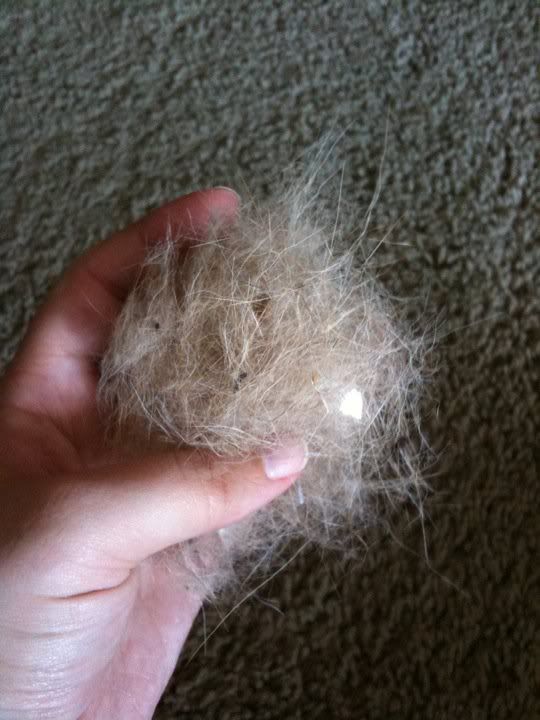 *weep* It's a good thing I love these dogs...
|
|
|
|
pandrax posted:
Hee, he and Koji are smile buddies.  I find this IS Koji's show of affection, besides his tendency to lean on our legs or chew on our fingers. Other than that, he doesn't really show he "cares" like other dogs do. He is usually pretty subtle with his affection (which should not be confused with the excitement he gets when someone comes over or he meets someone new). Was it hard bringing him with you when you were coming home?
|
|
|
|
pandrax posted:Lastly, this one is interesting because in the start he's playing with a rope and shaking his head. I'm guessing that he does it to kill whatever he caught? Yep! That's pretty much it. And don't worry about the sitting. Koji tends to sit like a loose whore at times like that, too, and his hips are fine.  He also does this: He also does this: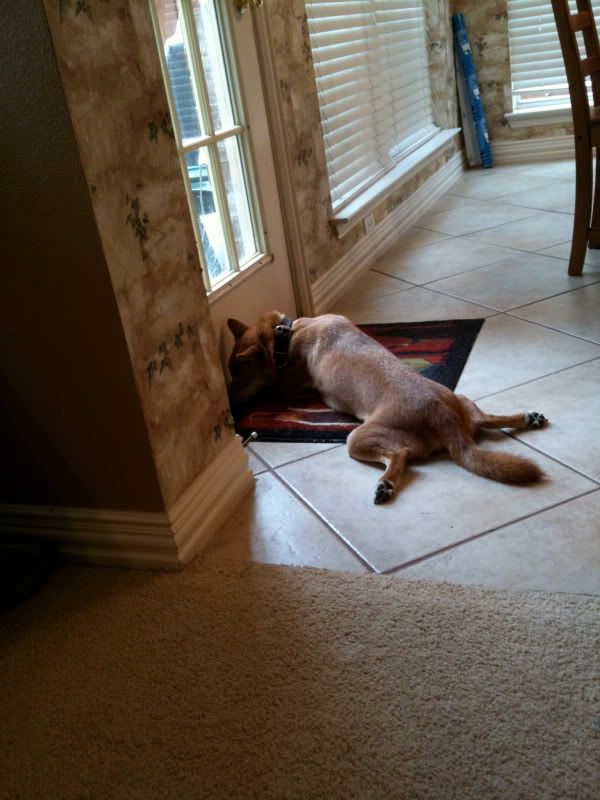 I call it "frog dog" or "chicken legs" since it makes him look like a butterflied chicken. He actually fell asleep like this, nose in the door, since I was tired of opening the door for him every 10 minutes to romp in the snow then bark to be let back in.  Kiri koli posted:Eskie talk with no pictures Yeah, every place rivals suggested is good. I generally use Photobucket for the bulk, flickr if I already uploaded something on there, but it is usually a little harder to link images (they changed their sharing option, so it's a headache to find it sometimes.) Go check out the two videos in the OP. There are a LOT of sounds going on, but they're all play sounds. It depends on the growl, too. Koji goes for more of a yell, personally. Just be sure you continue to train and socialize by shoving extra special treats in his mouth when he does something correctly. Koji barks every time he hears a door knock or a car he recognizes, but it's more of an alert than telling people to stay away, his tail always wags and if they don't get to him fast enough he cries.
|
|
|
|
pandrax posted:Since you commented back, I've gone full out with the NILF training. It works and it works fast. I'm having a harder time explaining to roommates and guests, than training Jolly to be in line. Spoiling him, or letting him get away with stuff (even if it's just for the camera) made him pretty unmanageable at times. I spent the last couple days with a water bottle and a bag of treats, and it made a big difference. I just wanted to update on that. The couch thing needs to be worked on - we seldom let him in but he does go straight to the couch. He sits before I give him a bowl of food (usually without telling him to, and if he doesn't sit, then he doesn't get anything until he does). I find him at his most unreasonable if he hasn't eaten in awhile. I hid all of the toys and he won't get most of them back for awhile. In the past I've found most of the backyard drama between the two dogs has been over rawhide and bones - so I'm cutting those out completely and just going to use treats that will be gone fast instead of something that he can be aggro/possessive over for hours to days. Oh, that's great to hear! And yes, it's pretty hard to convince other people to follow your training techniques. I hear a lot of times of people having a hard time of ignoring the dog that jumps all over them when they come in the door because the jumping just means he loves you and isn't rude and why wouldn't EVERYONE love that?! Keep us updated on Jolly!
|
|
|
|
Okay, these pictures STILL crack me up, and I just need to post them for y'all. I was "hired" to take pictures of my friends' dogs out in the bluebonnets when they were nice and blooming, and I tagged Koji along so I could get pictures too, why not? OH MY GOD they were all more distracted than usual and no amount of usage of the word "treat", kissy noises, squeakers or calling their name would get their goddamn attention. These were all taken in quick succession with a rapid fire feature on my camera. Jiro is the sesame (left), Koji in the middle, and Yuki is the creamie on the right. This, ladies and gents, is my dog:  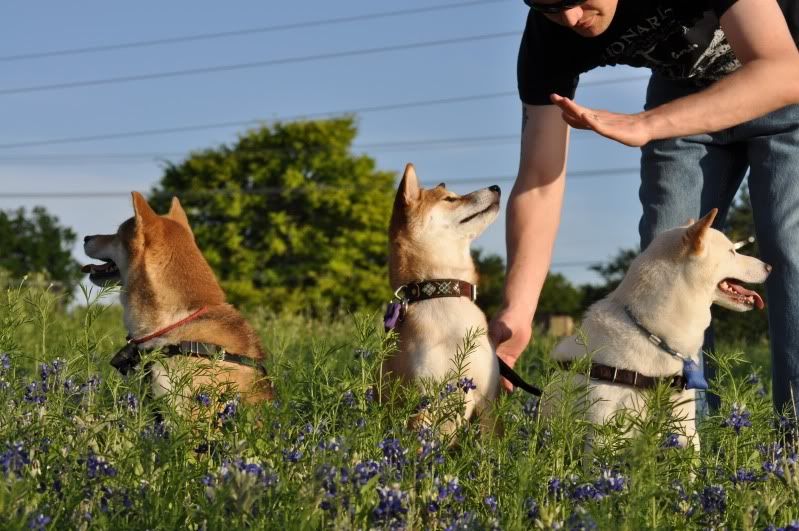 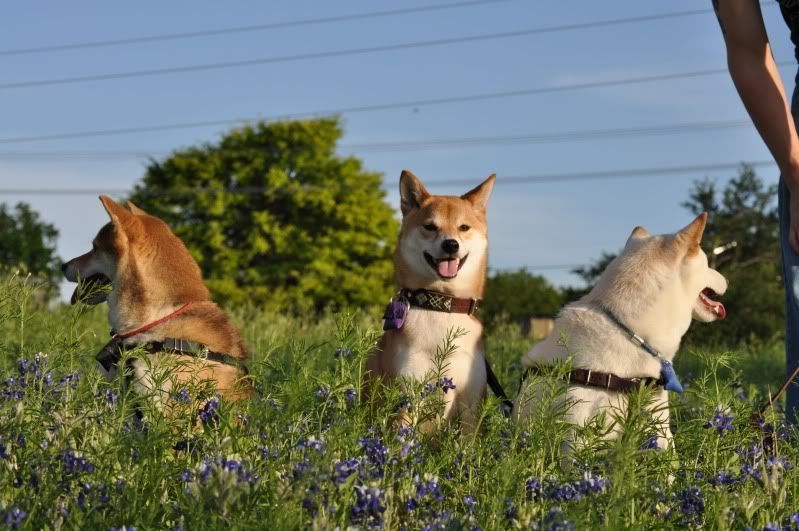  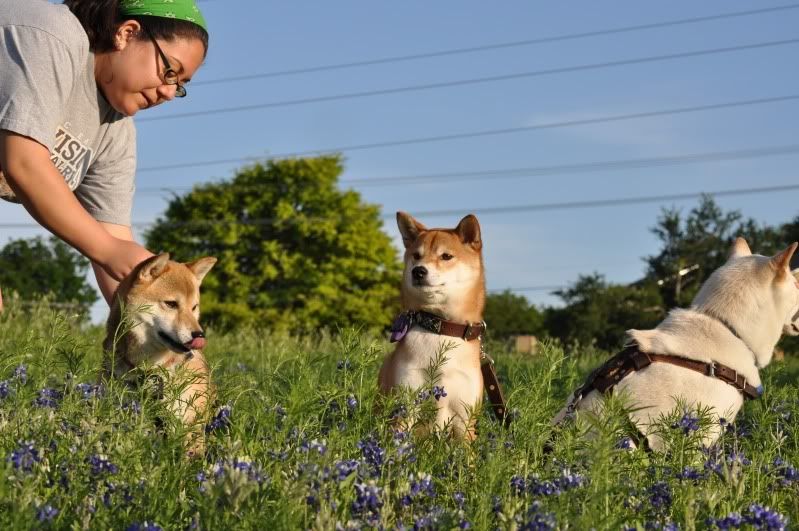 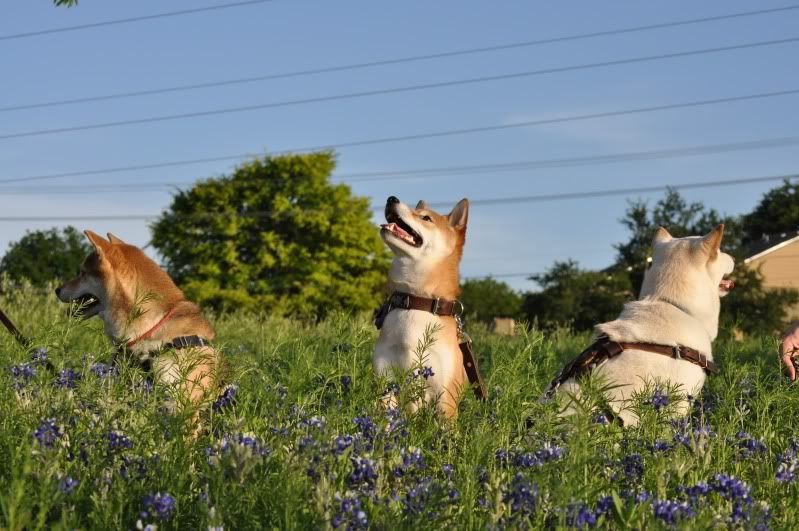 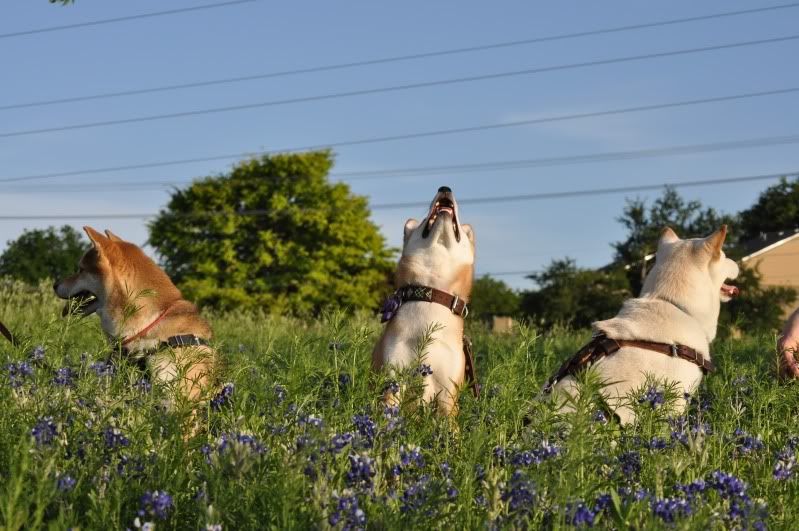 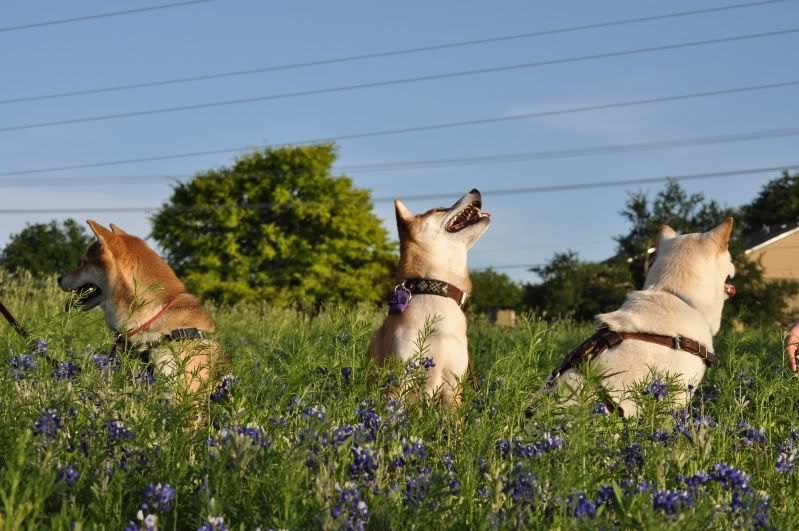 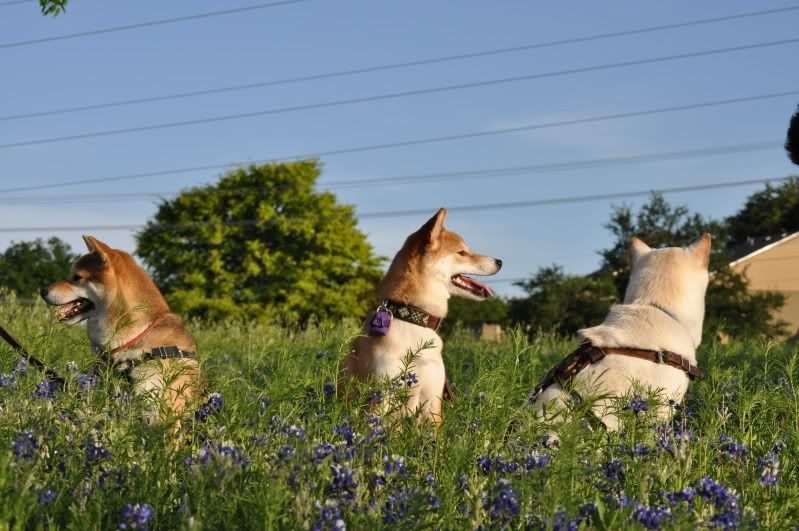 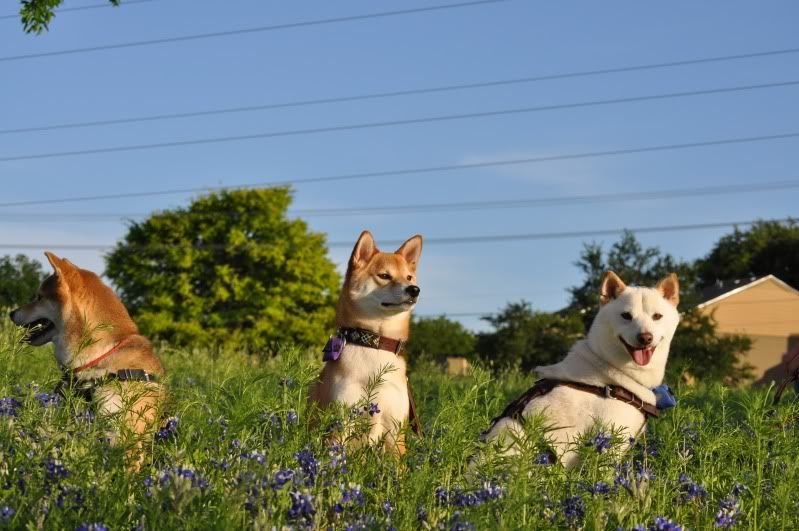 Seriously. Yuki was the only one to take a ton of pretty pictures.
|
|
|
|
Way to make me look inadequate, Wolf!  My post writings are all kinds of jumbled and I feel like I'll never get them done (but yesterday was my anniversary, so I was busy, damnit!) So, uh...Here's a picture of Hachi to let everyone know I have been working on it. And how loving cute he was. 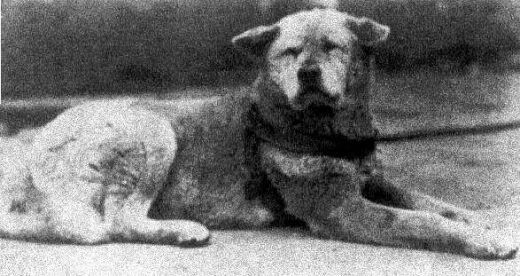
paisleyfox fucked around with this message at 00:42 on Sep 15, 2010 |
|
|
|
a life less posted:ETA: Also, I think it's interesting that you mentioned that the more "wolfy" looking hybrids tended to have the more wild temperaments. It makes me wonder if this mirrors the same things that happened in Russia during the silver fox study -- the foxes bred for softer, friendlier temperaments adopted more dog like features and coloration, where the more wild ones maintained their wilder appearance. The study suggests that the gene tied to the prolonged puppyhood most dogs experience is also tied to coat colour, ear carriage and tail shape. Yeah, I always found this really fascinating and I wish there was some sort of class at a school nearby that I could take that talked about this. But I'm sure this sort of class would totally go into very advanced genetics and whatnot (but I think I'd still enjoy it.)
|
|
|
|
RizieN posted:I could stare at this picture for forever. They look like cartoons~!
|
|
|
|
Not agility (these guys in particular would never DREAM of listening to do something like that...), but last night we had a meetup at the dog park! No one came except the usuals (my friends and I) though other people RSVP'd yes. Blurry because it was dark and those suckers move fast. :< Koji says "Who dat is?"  Bailey and Yuki  Koji wants to call it a night...  The others don't   Okay, maybe Yuki...  Bailey standing pretty.  EVERYONEBUMRUSHTHEGATE!NEWDOGS! (actually, two dogs they all knew)  Those agility dogs all look like they're having a GREAT time.
|
|
|
|
Totally geeking out here. First off, hubby said we could get an Akita after we get a house, which by the time we're settled and all probably won't be for about a year or more, but still. So I've just recently gotten in contact with an awesome breeder out in Cali to pick his brain and get familiar, and turns out he was the President of the LA branch of the Akita Inu Hozonkai for 6 years, and he's going to Japan for his 7th visit this December to visit breeders and attend the big show in Nagano. AAH.  (ohgodIwantanAkitapuppywtfisWRONGwithme?!)
|
|
|
|
Hahah, nah. We'll be staying in the area (hopefully just moving down the street from where we already live, nice affordable houses there and we love where we are right now), it's just there are only a small handfull of AI breeders in the US and one of them that I like is not only in California but less than an hour from my sister! So when I go home to visit family (I grew up in LA), we can just trek over to their place and geek out over their dogs (they said they had someone over recently and they just hung out with the dogs and talked for five hours!
|
|
|
|
Haha, sure! Their page is actually prety bad, but it's here: Kobun Kennels There's some pictures of a few of their puppies on this page, though (a GREAT resource I've been using for the writeup). I LOVE all the colors, I don't know if I'll be able to choose. The red brindles are a favorite, then I see the reds, then the regular brindle...aaah. I'll probably just have to have Ben choose for me.
|
|
|
|
That's because these are Japanese Akitas, and Akitas that most people have seen are the American type, where they are broader, stockier, have a more bear-like face and the pinto markings is not only more common but accepted, where in JAs, it's a serious fault (lots of huffy reasons for this I'll cover in my post.) Personally, I prefer JAs to AAs, but they're both awesome dogs. There are only slight temperament differences between the two, though looks are the huge difference, which is why many other places consider them two breeds (except Canada and USA, because we're apparently retarded...) If one of these dogs were to be shown in the opposite show (JA in AKC or AA in NIPPO) they'd so lose.
|
|
|
|
Pardalis posted:Are any of you guys going to go into detail on some of the rarer primitives like Tosa Inus? I don't know much about them but they seem interesting and I would love to read more! I wasn't planning on writing about Tosa (since they're pretty much Japanese Mastiffs) but I do have a bit of information on them in one of my books I'd be more than happy to share! They actually kind of tie into Akita history a little bit as well. And WB, don't worry, I've written on why there is such a difference. (spoiler: it wasn't entirely our fault!) I keep trying to finish this up at work, but weekend shifts are hard since I'm the only one working during the day. :P
|
|
|
|
AND I have the next four days off so I'll be busting my rear end to get those articles out. I won't let Wolf put me to shame!
|
|
|
|
Exactly. Purple tongues are something breeders strive for in Chows and Shar Peis, but blue tongues (or spots, such as on my Shiba) don't necessarily mean they are part Chow or Shar Pei. It's better to think of them as more like freckles, or hyperpigmentation on the tongue. I believe it's a recessive trait in dogs. That said, just because there is NO blue tongue, doesn't necessarily mean they aren't part Chow or Shar Pei. WolfensteinBag posted:You know, I was thinking about different Primitive dogs and how dogs like Shibas, Akitas, Basenjis, etc. are different from sledding/spitzy dogs, and I think I figured out how you can pin it down. Obviously each breed is going to be different based on what exactly they were bred for, but I think where sledding/spitz breeds tend to keep a lot of wolfy behaviors in the way they interact with eachother and with humans, more Japanese/feral type dogs are more like Village Dogs, or the predecessors of the domestic dog. They seem to have more of the "gently caress you" attitude than other breeds in that they are SO instinctively out for themselves, because wild dogs would have to be to survive. Just a thought, I figured I'd see what the rest of you (especially Pfox) think, since I have less experience with those types of breeds. You know, I think that's a fair observation, Wolf. It's just the more I'm really reading about the breeds I'm not entirely familar with and writing my breeds, the more it's just so fascinating how similar and dissimilar these dogs are from one another. And it's just so funny. Because many of these dogs aren't the lovey snuggle bunny kind of dogs, but Koji (and other Shibas I know) wants to be in the same room as I am in, but never all upons me. For example, right now I'm in the living room and he's sleeping on his bed across the room. If I'm in the bathroom for a while for a shower, he'll curl up outside the door, if I'm in the kitchen, he'll watch me from the hallway (though honestly, might be because of the food), and if I want to be in the bedroom, he'll want to curl up on his bed in there. Now, this isn't always the case, but it's just like he wants to get a feeling for where I am but never wants to cuddle or get really close, he just needs to know where his people are, in a way. At the dog park, he'll run back and check I'm still wherever I was, but won't come close enough for me to get him unless he's practically dead on his feet.  For such independent "gently caress you!" kind of dogs, they still are dogs and sometimes we really have to remember that we bred these puppy-like dog traits into them from their wild predecessors. We want them to be independent thinkers, solve puzzles and be self sufficient, but we also want them to look toward us for guidance, see us as all things good and awesome and give us trust, which I find is the reward and the goal in owning these kinds of dogs, not the everloving doting kisses to any joe on the street like with other dogs. So much work and consistency every day until the dog dies, but it's so worth it.
|
|
|
|
I love Buddy photospams.  Someone had to fill out between last year and now...) Someone had to fill out between last year and now...)
|
|
|
|
WolfensteinBag posted:What's Koji's costume?? Do you have any pictures of him in it from last year? HA Buddy's sounds cute!! Koji was a Ghostbuster: K-9 Unit See, his chest kind of Fabio'd at the end of last year's event, which is why I'm wondering if he'll fit this year... Might have to see if I can't either fix this or make a new one (saving the patches, of course) 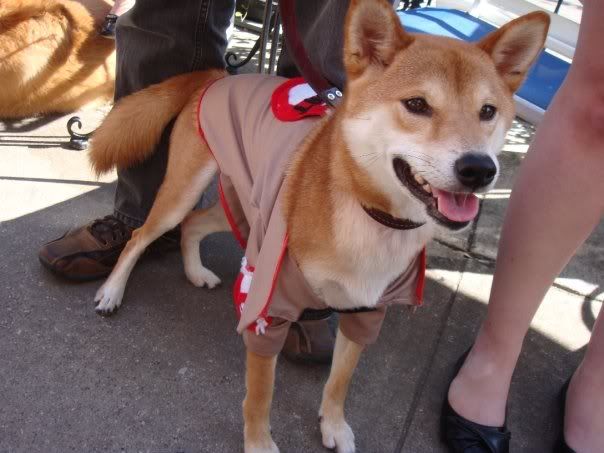 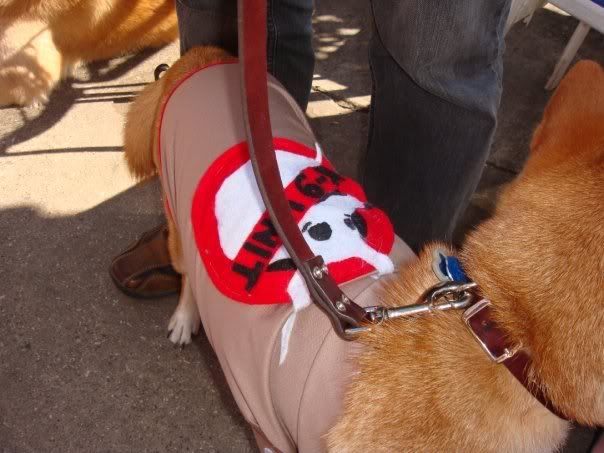 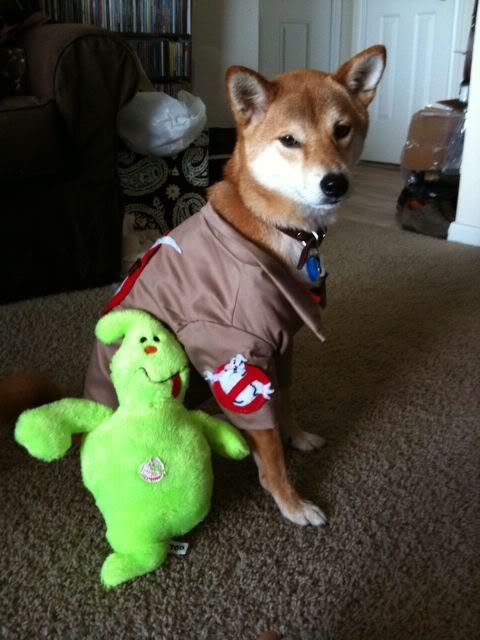 It was totally my first time trying to make a doggy shirt. I think I know better for next time (dog proportions are different from human ones, who knew~!  ). ).EDIT: OMG Thor is ADORABLE!
|
|
|
|
WolfensteinBag posted:Baahahahaha!! I knooow! I am trying to think of a way to do like, a proton saddle bag for him (he barely tolerates the shirt!) Probably won't be done for this weekend (I'm making a Dr. and a TARDIS costume for two of my friends' dogs  ) He needs a new ghost, though. We made sure he had limited play until after the event, then he KILLED it. ) He needs a new ghost, though. We made sure he had limited play until after the event, then he KILLED it.
|
|
|
|
Hahah, um, okay. I have this picture...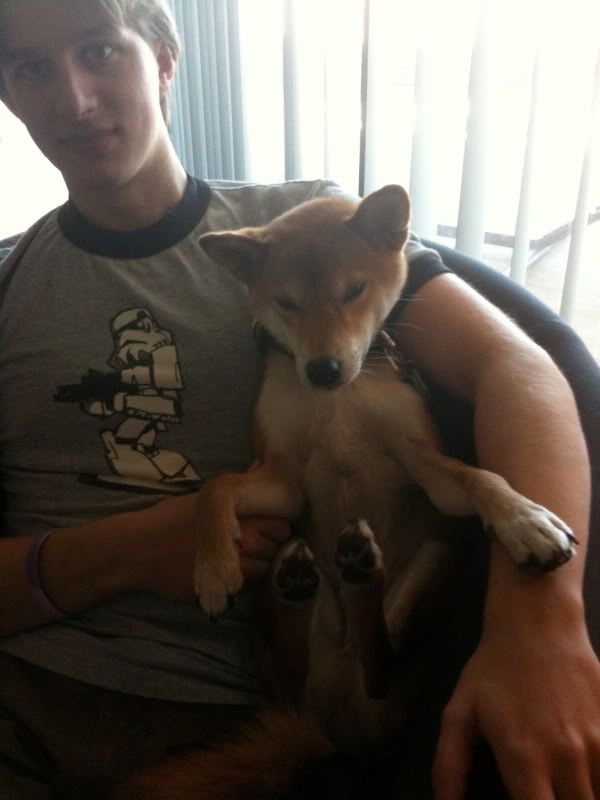 Friend made him look SO undignified.  If you need another/more whatever, let me know. If you need another/more whatever, let me know.BTW, I'm just getting photos finished. BREED POST SOON.
|
|
|
|

|
| # ¿ Apr 28, 2024 03:20 |
|
Akita; The Great Japanese Dog The largest of all native breeds in Japan, the Akita is named after the prefecture in northern, snowy Japan where it is said the breed originated. These dogs are one of the most popular in Japan, trailing closely behind the Shiba if only for their size. Akita were originally used as working dogs, generally alone or in pairs for hunting large game such as bear, boar and deer, alongside people known as the Matagi, a specially licensed mountain man with year round hunting permit. Akita were used to bay their prey until the hunter could catch up and kill their prize. In addition to hunting, Akita were used as fighting dogs during the Edo period (1600s - mid 1800s) and samurai took note of their “fighting spirit.” Dog fights in Japan differ greatly than what we normally consider to be a dog fight in the western world. One noticeable difference is that the purpose of dog fighting is not to injure the opponent, almost like a canine-sumo. Japanese Dogs posted:The dogs fight in a way that avoids causing severe injury to the opponent, with the first dog who manages to pin the other to the ground declared the winner. In addition, a dog is defeated if it whines, shrieks, groans, tries to run away, or becomes too tired to fight. Breeders are very careful not to let the dogs injure one another. If the dogs begin to bite each other, the owner will flick a cigarette lighter right by their heads; this surprises them enough so that they release their grip and can be pulled apart. In an effort to create stronger fighting dogs, Akita were crossed with many European and American breeds and continued through the 1900s (and where the Tosa was developed from, the crossbreeding of foreign and native dogs to produce a mastiff-like fighting dog that eventually was greatly favored over the Akita and Shikoku.) Because cross breeding was starting to elminate the Akita, the Akita Inu Preservation Society (Akita Inu Hozonkai or AKIHO) was established in 1927, with the Nihon Hozonkai (NIPPO) established a year later to help preserve all native dogs. 1931, the Akita became a protected species and natural monument of Japan by the government and given the official name of Akita (since they had many names depending on where they originated.) Even through the honeymoon with Hachiko and its national treasure status, Japan considered these to be boring, run of the mill, local sort of dog that was absolutely everywhere, especially in the cold north, and they were no German Shepherd, which at the time was the in-dog to have. During WWII, food was not only hard to come by for civilians but nearly impossible to think of passing on to their dogs, while some even saw the canines as a food source. That in conjunction with the military paying handsomely for dog pelts to line officer coats (save white dogs, as it was seen as a sign of death and bad luck and German Shepherds since they were used as police and military dogs), the local dog like the Akita was hit hard by people killing them for various reasons as well as trying to cross them with other breeds so they wouldn’t be taken. The result was a mishmosh of what was Akita, but far from their supposed origins as the Matagi Inu. When the war finally ended in 1945, it is estimated that there were only about a dozen Akita left. What was left were mostly dogs that were crossed with new and exciting dogs from around the world; Mastiff, Great Dane, German Shepherd, Saint Bernard. The first dog shows started up in 1946, hosted by Morie Sawataishi, a man credited with huge effort in bringing back the Akita from near extinction. It was more of an informal celebration for friends and enthusiasts of the dying breed to show off their dogs. Apparently it was shocking to see about 40 or 50 dogs that were all supposedly the same breed. Skin hung loosly on some, tails didn’t curl on others, ears didn’t stand on a few, some had stumpy legs, some were huge, some were small and almost none of them matched each other, and most were young. In the 1950s, it was like everyone in the snow country had puppies to sell and every dog they sold was suddenly an Akita. Americans stationed in Japan were huge dog lovers, so the locals flocked to the bases and sold the pups to GIs, who paid extraordinary amounts of money for what they considered to be the best and bravest and fastidious of all dogs. At this time, there were two strains of distinct Akita that emerged while trying to perfect the standard; the Ichinoseki and Dewa. The Ichinoseki line was leaner with longer legs and tight skin with a tightly curled tail while the Dewa line was bred to have a barrel-like build, a blocky, shepherd head, sesame hairs on top of a looser, wrinkled skin and a tail known more as a “samurai” or “sickle” tail and a lot of Japanese argued over which was the more accurate and desireable build. It is the Dewa line of dogs that produced Kami and Go-Go, Hellen Keller’s dogs, and what was sold to Americans during the 50s and 60s. Of course, when the Japanese dog population was finally gaining ground, disaster struck once again. 1959, a distemper epidemic hit all over the country and it is said that somewhere from 70-80% of dogs were killed because of it. Luckily, Japan was able to bounce back successfully through the strong foothold they had been building since the war. One dog, two breeds? There is a HUGE divide in the Akita community. Should the American and Japanese Akita be regarded as two separate BREEDS or just considered to be different types of the same breed? Everyone except for the United States and Canada regard these dogs to be two separate breeds. Some enthusiasts even argue that they’d rather they be regarded as types so that the two can be cross bred to help with genetic traits and conformation, though many rings disallow such a cross. What exactly ARE the differences between the two, though? First off, the two breeds were developed by two different lines back in the 1940s and 50s wen standards were still being ironed out during the attempts of bringing back the breed from the devistation of the war. This resulted in two distinct looks: The Ichinoseki and the Dewa lines. Eventually, through several circumstances, the Dewa lines gravitated toward the Americans while the Japanese decided to favor the looks of the Ichinoseki lines. This resulted in the Americans developing and breeding their Akita with a broader structure, a more fierce/bear-like face, and loose skin, which fanciers had already grown to love about these dogs that they had been introduced to. Japan, on the other hand, had two lines to debate over and ultimately decided that the longer legged, leaner, foxier dog was more appropriate to Matagi-Akita dogs, though both lines can still be seen in Japan (with the Ichinoseki line being more prominent.) Which is a really round about way of saying that the biggest difference between these dogs is looks. American Akita:  akitaclub.org posted:General Appearance Japanese Akita:  akita-inu.com posted:General Appearance tl;dr? Maybe. The biggest differences are slight height/weight differences, eye shape, tail curl, colors/markings and stops. JA’s tend to favor a ratio of 50/50 head proportion while AA’s do a 40/60 (2/3) ratio, meaning in layman’s terms that the slope of the nose and size of the muzzle to the overall size of the top of the head is different (being shorter on the AAs than the JAs.) AAs allow any color, JAs only allow three, eyes tend to be more rounded on AAs and tails MUST curl tightly on JAs (double or single curl), sickle tails are considered to be a serious fault. Here, look at pretty pictures. 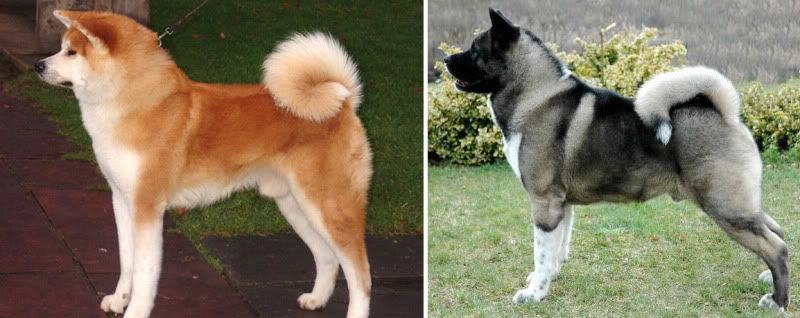 Japanese Akita on the left, American Akita on the right. Besides coat color, note the differences. Leg length, head shape, nose length, tail curl, ear tilt, eye shape, muzzle width. Temperaments Both sets of Akita share many similarities in temperament. First, Akita are very much one family dogs, and are valued for their loyalties toward their person. This can result in an under-socialized dog becoming snippy or moody around strangers, animal and human alike. They also tend to be a fairly active dog that requires a job or duty, which usually is guarding their home, and they are known to bore easily. Though while active, they are generally far less spastic than their Shiba cousins and are almost seen as laid back in comparison. Akita should be fearless and dominant, usually taking a leader or “I know better than you” role and they do require a firm and experienced owner. And though they have history of dog fighting, they should not actively look to pick fights, but it should be expected that they will engage if felt provoked. Akita also have tendencies to be same sex aggressive, so generally do best in homes with opposite sex dogs. Most temperament issues of the Akita stem from the fact that they are historically solitary dogs. There was never a need to use more than one or two at a time, so the breed standard has shown dogs that are merely tolerant if needed. A thoughtfully well bred Akita should be accepting of their human handlers and with extensive socialization and training have been known to get along with other dogs just fine, but early, appropriate and consistent training is the key.  Bonus! Bonus! 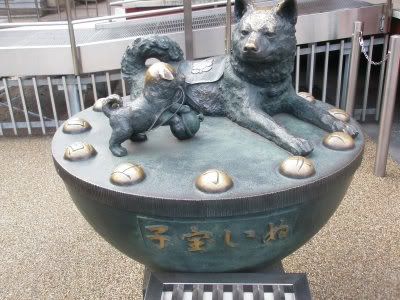 Dog Day - Inu no hi - Though not necessarily associated with an Akita, it is very traditional and more often than not observed inside of temples and shrines, as well as have associated charms and obi. Dogs have been associated with having an easy pregnancy and birth, so every 12 days (starting date based on the Chinese new year) women in their 5th month of pregnancy get blessed to have a dog’s pregnancy, usually while wearing something associated with dogs (generally a print on their clothing.) Kodakara Inu statue at the Suitengu shrine is the most famous. It pictures an Akita mom with her healthy puppy which visitors rub for good luck in an easy pregnancy, along with their corresponding zodiac sign. A Few Famous Akitas include: 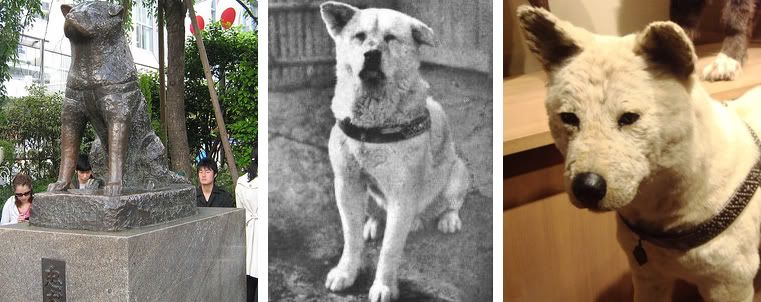 Hachiko - An Akita immensely famous not just in Japan, but world wide and is considered to be the gold standard of the breed. Hachi was born late in 1923 and given to an agricultural professor at the Imperial University (now University of Tokyo), Eisaburo Ueno. Bonding quickly, the two would walk to the train station together on the professor’s way to work, Hachi would find his way home, then meet the professor in the evening to walk home together. Spring of 1925, Ueno suffered a stroke while at work and did not return home, but Hachi continued to wait for him at the station for nearly 10 years, running away from various homes of friends and family members to do so. While waiting, Hachi suffered life-threatening mange, dog fights, hunger, and heartworm, which he eventually died from at the age of 12 in 1935. His bones were buried next to Professor Ueno and his pelt was preserved and is still on display at the National Science Museum in Ueno. Today, a statue stands in Hachi’s place at Shibuya Station at his favorite waiting spot and is a very popular meeting place for travelers. The original statue, created in 1934, was reclaimed by the government to be melted down for munitions during the war a decade later. The current statue is a remake, created in 1948 by the son of the original sculptor. 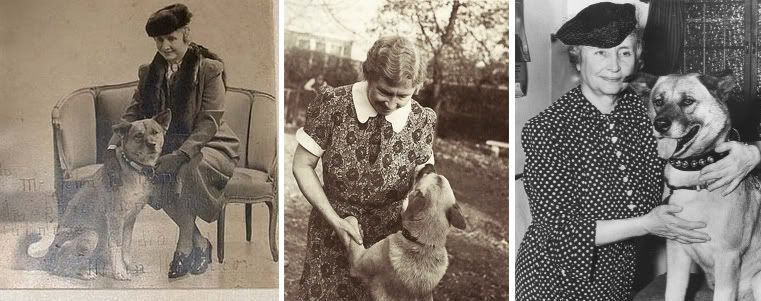 Kamikaze-Go and Kenzan-Go - Hellen Keller visited Japan in 1937 and inquired about Hachiko, a dog whom she had heard a lot about. Having expressed great interest in such a fantastic dog as him, Keller was given Kamikaze-Go within a month. Impressed with the loyalty and devotion of the breed, Keller doted on Kamikaze for his short life until he was put down from distemper at 10 months. Devastated, Keller was given Kami’s older brother, Kenzan-Go (whom she affectionately called Go-Go) in 1938. Keller is credited for introducing the Akita breed to the United States with Kami and Go-Go. Heiji - A mountain range in Central Kyushu frequently claimed several lives in accidents. In 1962, two hikers found themselves lost and in a panic when they ran across a dog they assumed to be someone’s pet. Following her down the volcanic mountain, Heiji led the hikers back to safety, where it was found she was in fact a stray. She was cleaned up, fed and eventually trained by the park warden of the Mount Kuju pass and continued to live by herself in the various passes and trails, coming around when she was hungry or in need of attention. Familiarized with all off the trails of the mountains (by Enokuma, the warden), Heiji found people lost in the mountains and would successfully guide them to safety on her own accord for 14 years, sometimes by just silently appearing in front of them and leading them down the pass. It wasn’t until she passed away that the people who lived near these notoriously dangerous mountains in Kyushu realized that since Heiji started “working”, there was not a single accident that involved loss of life or limb. Rescue and Breed links Japanese Akita Club of America Akita Club of America Akita Rescue Listing Also, I HIGHLY recommend the book Dog Man to anyone interested in reading a more detailed account of reestablishing the Akita after the war. It's a rather detailed story told by Morie Sawatashi and his wife that's been written down by the author. Fascinating read! (Plus, holy crap, it's under 4 bucks on Amazon.) fake edit: I didn't include a whole lot on the specifics of the show standards on each of these dogs. I do have diagrams and specific numbers if anyone is interested, though tbh, I'm kind of new to this whole show ring thing, seeing that I am not currently interested in doing any myself. Next up: Shibas! paisleyfox fucked around with this message at 06:23 on Sep 28, 2010 |
|
|


